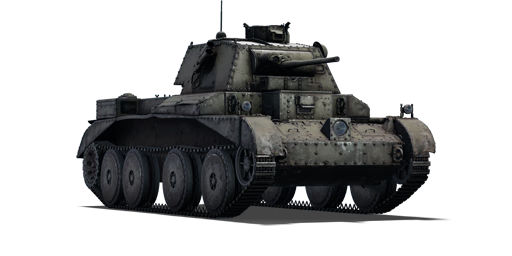

The Tank, Cruiser, Mark III (A13 Mark I) is the first variant of the A13 cruiser tank family. It was the third cruiser tank designed for the British Army. The tank is equipped with the Christie suspension system, which allows for higher speeds and better cross-country performance than previous cruiser tank families, which used triple-wheeled bogie suspension. Like other British cruisers, the A13 Mark I was quick but under-armed and mechanically unstable. The A13 Mark I was part of the British Expeditionary Force sent to France, and equipped units in the 1st Armoured Division, however, most of them were destroyed. In 1940-1941, a few were used in Greece and the Western Desert of Libya, supplying elements of the 7th Armoured Division. The design was used as the basis for the A13 Mark II.
Introduced in Update 1.55 "Royal Armour", the A13 Mark I is a highly manoeuvrable tank with a decent tank gun, good mobility, and extremely light armour. The A13 Mark I should not be utilized on the front lines. Instead, use your mobility to your advantage by spotting, flanking, and supporting your teammates while obscuring your foes with strategically placed smoke screens in key areas. Target isolated targets in flanking tactics to fully use the element of surprise and outflank your opponent. Never expose yourself for an extended period of time since even anti-aircraft guns are capable of damaging your light tank. In muddy terrain, however, the A13 Mark I may seem slow and has a tendency to slide sideways.
| Ammunition | Type | Armor penetration (mm) at a distance: | |||||
|---|---|---|---|---|---|---|---|
| 10 m | 100 m | 500 m | 1000 m | 1500 m | 2000 m | ||
| AP | 72 | 68 | 52 | 37 | 27 | 19 | |
| APCBC | 89 | 86 | 77 | 66 | 57 | 50 | |
| AP | 80 | 75 | 58 | 41 | 30 | 21 | |
| APHE | 66 | 62 | 49 | 36 | 26 | 19 | |
| Belt | Belt filling | Armor penetration (mm) at a distance: | |||||
|---|---|---|---|---|---|---|---|
| 10 m | 100 m | 500 m | 1000 m | 1500 m | 2000 m | ||
| IT/AP/AP | 13 | 12 | 7 | 3 | 2 | 0 | |








Mobility | |
|---|---|
Protection |
|---|
Firepower | |
|---|---|